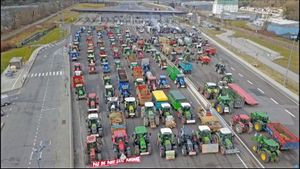South Korea is facing the unsettling prospect of numerous school closures this year, driven by declining student populations stemming from the country's persistent low birth rates. According to data released by the Ministry of Education and reported by the Korea Times on February 24, 2023, 49 schools are slated to cease operations, with 88% of them located in rural areas outside the capital, Seoul.
This alarming trend reflects the broader demographic crisis impacting South Korea, where the birth rate plummeted to 0.72 children per woman by 2023 – far below the 2.1 children needed to maintain population stability. The announcement of these closures marks the highest number recorded over five years, surpassing previous years when the number of closures was considerably lower. For example, the closures increased from just 22 schools last year to the current figure, raising concerns about the future of education, particularly in rural areas.
The breakdown of the schools set to close reveals regional disparities, with provinces like South Jeolla and Nam Chungcheong being the hardest hit, losing 10 and 9 schools respectively. This trend stands out starkly against the absence of school closures within Seoul itself, illustrating the growing educational divide between urban and rural regions.
Historical data shows the fluctuation of school closures over the years: 33 schools shut down in 2020, which dropped slightly to 24 closures in 2021 and remained under control for the next two years, only to rebound back to 33 schools by 2022. Surprisingly, last year saw 112 primary schools unable to enroll any new students, indicating this trend is not just limited to impending closures but reflects deep-seated enrollment issues.
Spearheading these closures are elementary schools, of which 38 are set to shut their doors, alongside 8 middle schools and 3 high schools, representing significant losses across all educational levels. Regions such as North Jeolla also contribute to the grim statistics with 34 primary schools failing to register any new students last year.
The root of these closures can be traced back to the declining birth rates, which have fallen consistently over the years. South Korea's government has invested over $320 billion over the past two decades to incentivize larger families through various programs. Despite these attempts, such as providing support to low-income families, they have not significantly addressed underlying issues such as housing costs and job stability, which are major factors discouraging young couples from starting families.
The current climate presents almost insurmountable challenges for the South Korean government, with projections indicating the population will begin to decrease by next year and could fall by one-third over the next forty years. More dire is the forecast predicting the workforce may halve by 2065, leading to potentially severe economic and social ramifications.
Government officials and agencies insist on exploring new avenues to effectively halt this demographic decline. Yet, skepticism remains as past strategies focused on short-term parental subsidies rather than the need for addressing long-term economic stability and living conditions for families.
Often overlooked is the emotional toll this crisis takes on communities beyond the stark data. The closure of schools doesn't just affect students, but ripples through local economies, raising concerns about loss of community identity and cohesion. School communities are often central hubs of rural life, and their disappearance could lead to broader societal issues.
Without significant change, families contemplating children may continue to shy away due to the high cost of raising children and the prevailing economic uncertainty. Closing schools serve as both a symptom and catalyst of this demographic slowdown, translating to lost opportunities for children’s education and futures.
South Korea stands at a crossroads, and the next steps taken by its government could prove pivotal not just for education, but for preserving the fabric of its society and the promise of the next generation.



